| Latest | Greatest | Lobby | Journals | Search | Options | Help | Login |
|
|
|
This topic is archived. |
| Home » Discuss » Topic Forums » Sports |
|
| Jack Rabbit
|
Sat Oct-03-09 07:09 PM Original message |
| The JR CHess Report (October 3): Magnus Magnificent in Nanjing |
|
Edited on Sat Oct-03-09 07:19 PM by Jack Rabbit
Magnus Magnificent in Nanjing at Halftime
 Eighteen-year-old grandmaster Magnus Carlsen of Norway is running away at the half-way point with the second annual Pearl Spring Tournament in Nanjing with 4½ points out of five rounds to lead his nearest rival by two points. Magnus is the only player to win a game in the first half of the tournament. He's won four games. Chinese grandmaster Wang Yue, the only player to hold Magnus to a draw in the first half, is in second place with 2½ points. Wang has drawn all of his games. Today was a rest day for the players. Action will resume tomorrow at 3 pm Nanjing time, which is tonight at Midnight PDT. The games will be broadcast live at the official tournament website. Nana Leads Women's Grand Prix  Georgian grandmaster Nana Dzagnidze leads a field of 12 players in the second leg of the Women's Grand Prix in Nanjing with 4 points in the first five rounds. Ms. Dzagnidze won her first four games in a row before losing to French grandmaster Marie Sebag in yesterday's fifth round. Former world women's champion Xu Yuhua of China is second with 3½ points. Like Ms. Dzagnidze, Ms. Xu was without a loss until the fifth round when she fell to Mongolia's Batkhuyag Munguntuul. As in the Pearl Spring Tournament, which is also being played at the Pearl Spring Holiday Resort in Nanjing, today was a rest day for the players with the action resuming tomorrow at 3 pm Nanjing time (tonight at Midnight PDT). The games will be broadcast live at the official website of the twin Nanjing tournaments. SPICE Cup Ends with 3-Way Tie http://4.bp.blogspot.com/_Q0lTtPVTG40/Sqlz4zfpsTI/AAAAAAAA7_o/FabWgEut9uc/S217/2009+SPICE+Cup+TTU+Cover+2.tif.jpg Rauf Mamedov of Azerbaijan defeated Norway's Jon Ludvig Hammer in the final round Thursday to join Ukrainian GM Yuriy Kuzubov and Dmitry Andeikin of Russia as co-champions of the 2009 SPICE Cup at Texas Tech University in Lubbock. Jon Ludvig had been leading the tournament with Kuzubov and Andeikin most of the way. but dropped each of his last two games to fall back. The event saw a number of fighting draws but few decisive game. Mamedov, Kuzubov and Andeikin each won only one game while drawing nine to share first place. Calendar World Junior Championship, European Club Cup (Team Championship), Novi Sad (Serbia) 21-31 October. Tal Memorial Tournament, Moscow 5-14 November. Anand, Aronian, Carlsen, Gelfand, Ivanchuk, Kramnik, Leko, Morozevich, Ponomariov and Svidler. World Youth Chess Championship, Antalya (Turkey) 11-23 November. World Cup, Khanty Mansiysk 28 November-15 December. London Chess Classic 7-16 December. Corus Chess Tournament, Wijk aan Zee 15-31 January 2010. Nakamura has been invited to play in group A. Anand-Topalov Match for the World Title, Site TBA c. April 2010. On Edit Games will be posted later. I have to go to the store and get a bag of cat food for my impressive staff. |
| Printer Friendly | Permalink | | Top |
| madinmaryland
|
Sat Oct-03-09 07:15 PM Response to Original message |
| 1. So I will have to stay up until 3:00am edt?? |
|
:wtf:
I'll be long gone by then. Can I dvr a webcast? :D |
| Printer Friendly | Permalink | | Top |
| Jack Rabbit
|
Sat Oct-03-09 11:43 PM Response to Reply #1 |
| 14. Don't worry about it. |
|
I'll watch the opening moves of Magnus' game for both of us. He's playing Black against Leko tonight. Or tomorrow afternoon. Or whenever.
You can get up in the morning and watch the ending for both of us. |
| Printer Friendly | Permalink | | Top |
| Jack Rabbit
|
Sat Oct-03-09 08:17 PM Response to Original message |
| 2. This week's games |
|
Your humble hare acknowledges the assistance of Fritz 6.0 on analysis. Diagrams on the Jack Rabbit Chess Report are made with Chess Mérida, a true type font that can be downlaoded free here. !""""""""# $tMvWlVmT% $OoOoOoOo% $ + + + +% $+ + + + % $ + + + +% $+ + + + % $pPpPpPpP% $RnBqKbNr% /(((((((() WHITE White to move (This position is a theoretical draw) I would like to thank my impressive and loyal staff: Buccaneer, Spitfire, Swashbuckler, Pancho and Robin Hood |
| Printer Friendly | Permalink | | Top |
| Jack Rabbit
|
Sat Oct-03-09 08:20 PM Response to Reply #2 |
| 3. Second Pearl Spring Tournament, Nanjing |
 City Wall of Nanjing, Ming Dynasty |
| Printer Friendly | Permalink | | Top |
| Jack Rabbit
|
Sat Oct-03-09 08:21 PM Response to Reply #3 |
| 4. Jakovenko - Calrsen, Round 4 |
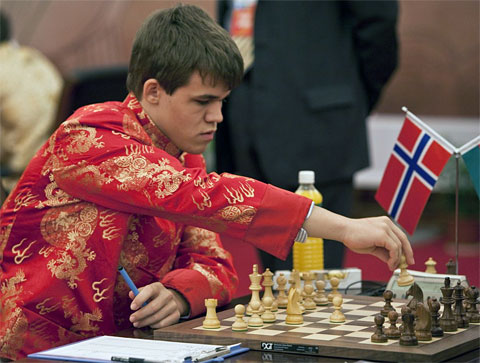 Magnus Carlsen in Nanjing Dmitry Jakovenko - Magnus Carlsen Pearl Spring Tournament, Round 4 Nanjing, 1 October 2009 Open Sicilian Game: Najdorf-Boleslavsky Defense (Opocensky Opening) 1.e4 c5 2.Nf3 d6 3.d4 cxd4 4.Nxd4 Nf6 5.Nc3 a6 6.Be2
6...e5
7.Nb3 Be7 8.0-0 0-0 9.Be3
9...Be6 10.Qd2
10...Nbd7 11.a4 Nb6
12.a5 Nc4 13.Bxc4 Bxc4 14.Rfd1 Rc8
15.f3
15...Rc6 16.Kh1!?
16...Qc8
17.Rac1 !""""""""# $ +w+ Tl+% $+o+ VoOo% $o+tO M +% $P + O + % $ +v+p+ +% $+nN Bp+ % $ PpQ +pP% $+ Rr+ +k% /(((((((() WHITE: Dmitry Jakovenko Position after 17.Ra1c1 17...Rd8!?
18.Nd5 Bxd5
19.exd5 Rc4 20.Qd3 e4 21.fxe4 Rxe4 22.c4 Re8 23.Bg1
23...Bf8 24.Nd4 g6 25.Rf1 Bh6 26.Qf3 Rf4!?
!""""""""# $ +w+t+l+% $+o+ +o+o% $o+ O MoV% $P +p+ + % $ +pN T +% $+ + +w+ % $ P + +pP% $+ R +rBk% /(((((((() WHITE: Dmitry Jakovenko Position after 26...Re4f4 27.Qd3!
27...Ng4!?
28.Nf3!?
28...Rfe4!
29.Rc3 Ne3!
30.Re1 Qg4!?
31.Re2 Qh5 32.Bxe3 Rxe3 33.Rxe3 Bxe3!?
34.Qe2 Qh6
35.c5!
35...dxc5 36.d6
!""""""""# $ + +t+l+% $+o+ +o+o% $o+ P +oW% $P O + + % $ + + + +% $+ R Vm+ % $ P +q+pP% $+ + + +k% /(((((((() WHITE: Dmitry Jakovenko Position after 36.d5d6 36...Re6!
37.d7 Bg5 38.Qd1
38...Bd8
39.Rxc5 Qf8 40.Rd5
40...Qb4 41.b3
41...Re3 42.Nd2 Qc3 43.Nf3
43...Qb4 44.Nd2 Qf4 45.Nf3 Rc3
46.Qe2
46...Qe3 47.Qxe3 Rxe3 48.Rd4 Kf8 49.Rb4!?
!""""""""# $ + V L +% $+o+p+o+o% $o+ + +o+% $P + + + % $ R + + +% $+o+ Tn+ % $ + + +pP% $+ + + +k% /(((((((() WHITE: Dmitry Jakovenko Position after 49.Rd4b4 49...Rd3!
50.Rxb7
50...Rd1+!
51.Ng1 Bxa5 52.g4?
52...Ke7!
53.Kg2 Rxd7 54.Rxd7+ Kxd7 55.Kf3
55...Kd6 56.Ke4 Kc5 57.Kd3
!""""""""# $ + + + +% $+ + +o+o% $o+ + +o+% $V L + + % $ + + +p+% $+p+k+ + % $ + + + P% $+ + + N % /(((((((() WHITE: Dmitry Jakovenko Position after 57.Ke4d3 57...Kd5!
58.Nf3 Bd8 59.h3 h6 60.h4 h5 61.gxh5
61...gxh5 62.Ke3 Kc5 63.Kd3 Kb4 0-1
|
| Printer Friendly | Permalink | | Top |
| Jack Rabbit
|
Sat Oct-03-09 08:23 PM Response to Reply #3 |
| 5. Carlsen - Leko, Round 1 |
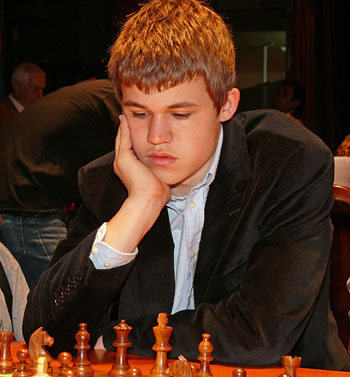 Magnus Carlsen Magnus Carlsen - Peter Leko Pearl Spring Tournament, Round 1 Nanjing, 28 September 2009 Open Royal Game: Classical Defense (Scotch Opening) 1.e4 e5 2.Nf3 Nc6 3.d4 exd4 4.Nxd4
4...Bc5
5.Be3
5...Qf6 6.c3 Nge7 7.Bc4
7...Ne5
8.Be2 Qg6 9.0-0 d6 10.f4
10...Qxe4 11.Bf2 Bxd4 12.cxd4 N5g6 13.g3
13...0-0
14.Nc3 Qf5 15.d5 a6!?
16.Re1
16...Kh8 17.Rc1
17...Bd7
18.Bf3
18...Rac8!?
19.Qb3
!""""""""# $ +t+ T L% $+oOvMoOo% $o+ O +m+% $+ +p+w+ % $ + + P +% $+qN +bP % $pP + B P% $+ R R K % /(((((((() WHITE: Magnus Carlsen Position after 19.Qd1b3 19...b5!?
20.Ne2!?
20...Qh3 21.Nd4 Bg4 22.Bg2 Qh5 23.h4 Ng8
24.Rc6! Nf6 25.Rxa6 Bd7 26.Nxb5 Rb8 27.a4
27...Ng4 28.Bf3 Qh6 29.Qc4 Nxh4?
!""""""""# $ T + T L% $+ Ov+pPp% $r+ O + W% $+n+p+ + % $p+q+ PmM% $+ + +bP % $ + + B +% $+ + R K % /(((((((() WHITE: Magnus Carlsen Position after 29...Ng6h4:p 30.Bxg4!
30...Bxg4 31.gxh4
31...Bf3 32.f5 Qh5 33.Qf4 Bxd5 34.Nxc7 Bb7 !""""""""# $ T + T L% $+vN +oOo% $r+ O + +% $+ + +p+w% $p+ + Q P% $+ + + + % $ P + B +% $+ + R K % /(((((((() WHITE: Magnus Carlsen Position after 34...Bd5b7 35.Rb6!
35...f6 36.Bd4 Qf7 37.Ne6 Rg8 38.Kf2 Rbc8 39.Bc3 Bd5 40.a5
40...Rc4 41.Nd4 Ba8 42.Qxd6 Qh5 43.Qf4 Rcc8 44.Rbe6 1-0
|
| Printer Friendly | Permalink | | Top |
| Jack Rabbit
|
Sat Oct-03-09 08:42 PM Response to Reply #2 |
| 6. Women's Grand Prix, Second Tournment, Nanjing |
| Printer Friendly | Permalink | | Top |
| Jack Rabbit
|
Sat Oct-03-09 08:52 PM Response to Reply #6 |
| 7. Dagnidze - Zhu Chen, Round 3 |
 Nana Dzagnidze Nana Dzagnidze - Zhu Chen Women's Grand Prix, Second Tournament, Round 3 Nanjing, 28 September 2009 Semi-Slav Queen's Gambit: Meran Defense (Main Line) 1.d4 d5 2.c4 e6 3.Nc3 c6 4.e3 Nf6 5.Nf3 Nbd7 6.Bd3 dxc4 7.Bxc4 b5 8.Bd3
8...a6
9.e4
9...c5 10.e5
10...cxd4 11.Nxb5 axb5 12.exf6 gxf6
13.Nxd4
13...Bb7
14.Bxb5!?
14...Rg8
15.Be3 Qa5+ 16.Ke2 Rxg2
17.a4 Bd5 18.Rc1 Rg4
19.h3 Rg6?
!""""""""# $t+ +lV +% $+ +m+o+o% $ + +oOt+% $Wb+v+ + % $p+ N + +% $+ + B +p% $ P +kP +% $+ Rq+ +r% /(((((((() WHITE: Nana Dzagnidze Position after 19...Rg4g6 20.Nc6!
20...Qc7 21.Ne7 Qe5 22.Nxd5 exd5
23.Qd4!
23...Bd6 24.Rhe1 Kd8 25.Kf1
25...Qh5
!""""""""# $t+ L + +% $+ +m+o+o% $ + V Ot+% $+b+p+ +w% $p+ Q + +% $+ + B +p% $ + + P +% $+ R Rk+ % /(((((((() WHITE: Nana Dzagnidze Position after 25...Qe5h5 26.Qb6+
26...Ke7 27.Bc5+!
27...Kf8 28.Qxd6+ Kg7 29.Bxd7 Qf3 30.Rc3 Qg2+ 31.Ke2 Qe4+ 32.Kd2 Qh4 33.Re8 1-0
|
| Printer Friendly | Permalink | | Top |
| Jack Rabbit
|
Sat Oct-03-09 08:53 PM Response to Reply #6 |
| 8. Mkrtchian - Xu Yuhua, Round 3 |
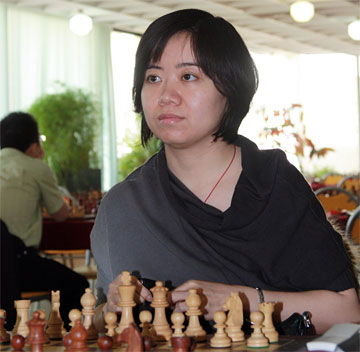 Xu Yuhua :ilit Mkrtchian - Xu Yuhua Women's Grand Prix, Second Turnament, Round 3 Nanjing, 30 September 2009 East India Game: Nimzo-Indian Defense (Capablanca Opening) 1.d4 Nf6 2.c4 e6 3.Nc3 Bb4 4.Qc2 0-0 5.a3 Bxc3+ 6.Qxc3 d5
7.e3 b6 8.Nf3 Nbd7!?
9.b3
9...Ba6 10.Bb2 c5 !""""""""# $t+ W Tl+% $O + +oOo% $vO +oM +% $+ Oo+ + % $ +pP + +% $PpQ Pn+ % $ B + PpP% $R + Kb+r% /(((((((() WHITE: Lilit Mkrtchian Position after 10...c7c5 11.Rd1?
11...Rc8 12.Nd2
12...Qe7 13.Be2 dxc4 14.Nxc4
14...b5!
15.Qa5 bxc4 16.Qxa6 cxd4 17.bxc4
17...Nc5 18.Qa5 dxe3
19.fxe3 Qb7!?
20.Bxf6 !""""""""# $ +t+ Tl+% $Ow+ +oOo% $ + +oB +% $Q M + + % $ +p+ + +% $P + P + % $ + +b+pP% $+ +rK +r% /(((((((() WHITE: Lilit Mkrtchian Position after 20.Bb2f6:N 20...Qxg2!
21.Rf1 gxf6 22.Qxa7 Qxh2
23.Rf2 Qe5!?
24.Qe7 Ne4 25.Rg2+ Kh8 26.Rd4
26...Rce8!?
27.Qb7 f5 28.Qb5
!""""""""# $ + +tT K% $+ + +o+o% $ + +oW +% $+q+ +o+ % $ +pRm+ +% $P + P + % $ + +b+r+% $+ + K + % /(((((((() WHITE: Lilit Mkrtchian Position after 28.Qb7b5 28...Qf6!
29.Rxe4
29...fxe4 30.Qb1 Qc3+
31.Kf2 f5 32.Rh2 f4 33.Qxe4 fxe3+ 34.Kg3
34...Rg8+
35.Kh3 Rg6 36.Rg2 Rh6+ 37.Kg3 Rg8+ 38.Bg4 e2+ 0-1
|
| Printer Friendly | Permalink | | Top |
| Jack Rabbit
|
Sat Oct-03-09 08:55 PM Response to Reply #6 |
| 9. Zhu Chen - Munguntuul, Round 2 |
 Zhu Chen Zhu Chen - Batkhyyag Munguntuul Women's Grand Prix, Second Tournament, Round 2 Nanjing, 28 September 2009 Semi-Slav Queen's Gambit: Stoltz Opening 1.d4 d5 2.c4 c6 3.Nc3 Nf6 4.e3 e6 5.Nf3 Nbd7 6.Qc2 Bd6 7.Bd3
7...0-0 8.0-0 dxc4 9.Bxc4 e5
10.h3
10...exd4
11.exd4 Nb6 12.Bb3 Nfd5!?
13.Re1
13...h6 14.Ne5
14...Be6 15.Ne4 Nb4!?
!""""""""# $t+ W Tl+% $Oo+ +oO % $ MoVv+ O% $+ + N + % $ M Pn+ +% $+b+ + +p% $pPq+ Pp+% $R B R K % /(((((((() WHITE: Batkhyyag Munguntuul Position after 15...Nd5b4 16.Qc3!
16...Bxb3
17.Qxb3 Bxe5 18.dxe5 Nd3 19.Bxh6!
19...Qd5!
20.Qc3 Na4 21.Qd2 f5?
!""""""""# $t+ + Tl+% $Oo+ + O % $ +o+ + B% $+ +wPo+ % $m+ +n+ +% $+ +m+ +p% $pP Q Pp+% $R + R K % /(((((((() WHITE: Batkhyyag Munguntuul Position after 21...f7f5 22.Bxg7!!
22...fxe4
23.Qh6
23...Rxf2 24.e6!
24...Rxg2+ 25.Kxg2 Nf4+ 26.Qxf4 Kxg7
27.Qxe4 Re8 28.Qxd5 cxd5 29.Rad1
29...Nxb2 30.Rxd5 Kf6 31.Rd2 Nc4 32.Rf2+ Kg6 !""""""""# $ + +t+ +% $Oo+ + + % $ + +p+l+% $+ + + + % $ +m+ + +% $+ + + +p% $p+ + Rk+% $+ + R + % /(((((((() WHITE: Batkhyyag Munguntuul Position after 32...Kf6g6 33.e7!
33...Kg7 34.Re6 Nb6 35.Re4 Nd5 36.Re5 Nxe7 37.Rf3 1-0
|
| Printer Friendly | Permalink | | Top |
| Jack Rabbit
|
Sat Oct-03-09 11:34 PM Response to Reply #2 |
| 10. SPICE Cup, Texas Tech University, Lubbock |
| Printer Friendly | Permalink | | Top |
| Jack Rabbit
|
Sat Oct-03-09 11:35 PM Response to Reply #10 |
| 11. Hammer - Mamedov, Round 10 |
|
Rauf Mamedov Jon Ludvig Hammer - Rauf Mamedov SPICE Cup (Group A), Round 10 Texas Tech University, 28 September 2009 Moorish Game: Little Dragon Defense (Robatsch Defense) 1.d4 g6 2.c4 Bg7 3.e4 d6 4.Nc3
4...e5 5.Be3 exd4
6.Bxd4 Nf6 7.f3 0-0 8.Nge2 a6!?
9.Qd2
9...Nc6 10.Be3 Ne5 11.Nf4 c6 12.b3!?
12...b5!
13.cxb5
13...axb5 14.Rc1
14...Re8 15.Be2 d5!?
!""""""""# $t+vWt+l+% $+ + +oVo% $ +o+ Mo+% $+o+oM + % $ + +pN +% $+pN Bp+ % $p+ Qb+pP% $+ R K +r% /(((((((() WHITE: Jon Ludvig Hammer Position after 15...d6d5 16.0-0?!
16...dxe4 17.fxe4 Qe7
18.Nd3?
18...Nxd3 19.Bxd3 Ng4 20.Kh1
!""""""""# $t+vT +l+% $+ + WoVo% $ +o+ +o+% $+o+ + + % $ + +p+m+% $+pNbB + % $p+ Q +pP% $+ R +r+k% /(((((((() WHITE: Jon Ludvig Hammer Position after 20.Kg1h1 20...Rd8!
21.Bf4
21...b4 22.Na4 Ba6 23.Nc5 Bxd3 24.Nxd3 Qxe4
25.Nc5
25...Rxd2 26.Nxe4 Re2 27.Rc4 !""""""""# $t+ + +k+% $+ + +oVo% $ +o+ +o+% $+ + + + % $ Or+nBm+% $+p+ + + % $p+ +t+pP% $+ + +r+k% /(((((((() WHITE: Jon Ludvig Hammer Position after 27.Rc1c4 27...f5!
28.Ng3 Rexa2
29.h3
29...Nf2+ 30.Kh2 Nd3 31.Bd6
31...Rb2 32.Rd1 Ne5 33.Rc5 Nf3+ 34.Kh1 Rd2 35.Rcc1
35...Rxd1+ 36.Rxd1 Nd4 37.Bxb4 Nxb3 38.Rd3
38...c5 39.Rxb3 Rb8!
40.Ne2
40...Rxb4 41.Rd3 Rb1+ 0-1
|
| Printer Friendly | Permalink | | Top |
| Jack Rabbit
|
Sat Oct-03-09 11:37 PM Response to Reply #10 |
| 12. Akobian - Kuzubov, Round 5 |
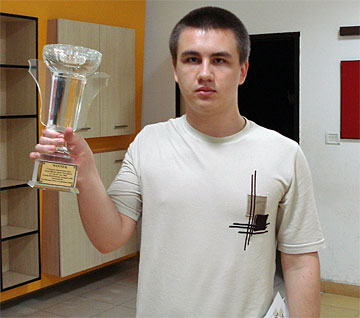 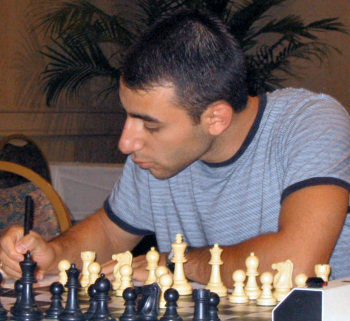 Yuriy Kuzubov and Var Akobian Var Akobian - Yuriy Kuzubov SPICE Cup (A Group), Round 5 Texas Tech University, 22 September 2009 East India Game: Nimzo-Indian Defense (Capablanca Opening) 1.d4 Nf6 2.c4 e6 3.Nc3 Bb4 4.Qc2 c5
5.dxc5 Bxc5 6.Nf3 Qb6
7.e3 Qc7 8.b3
8...a6 9.Bb2 Be7
10.g4 h6 11.0-0-0!?
11...b5
12.Nd4!?
12...Bb7!
13.Rg1 bxc4
14.Bxc4 Nc6 15.Nxc6 Qxc6 16.Kb1!? 16...Rc8 17.Qe2
17...d5!?
!""""""""# $ +t+l+ T% $+v+ VoO % $o+w+oM O% $+ +o+ + % $ +b+ +p+% $+pN P + % $pB +qP P% $+k+r+ R % /(((((((() WHITE: Var Akobian Position after 17...d7d5 18.Bd3!
18...Bb4
19.Na4 Qd6
20.h4 Kf8 21.g5 hxg5 22.hxg5 Nd7 23.Rh1 Rxh1 24.Rxh1 e5 25.Bf5
25...Rd8 26.Qg4!?
!""""""""# $ + T L +% $+v+m+oO % $o+ W + +% $+ +oOvP % $nV + +q+% $+p+ P + % $pB + P +% $+k+ + +r% /(((((((() WHITE: Var Akobian Position after 26.Qe2g4 26...Bc6!
27.f4!
27...Bxa4 28.fxe5!
28...Qb6 29.e6?
29...fxe6
30.Bxe6 Ke7 31.Bxd5 Nc5 32.Qd4 Qg6+ 33.Ka1 !""""""""# $ + T + +% $+ + L O % $o+ + +w+% $+ Mb+ P % $vV Q + +% $+p+ P + % $pB + + +% $K + + +r% /(((((((() WHITE: Var Akobian Position after 33.Kb1a1 33...Rxd5!!
34.Qxd5 Bc6 35.Qe5+ Ne6 36.Rc1 Bd7 37.Qd5
37...Qxg5 38.Qxg5+ Nxg5 39.Bxg7 Ke6
40.Kb2 Bd6 41.Rg1
41...Ne4 42.Bd4 Bb5 43.a4 Bc6
44.Rg6+ Kd7 45.Rg7+ Be7 46.Kc2
46...Ke6 47.Kd3 Nd6 48.Bc5 Be4+ 49.Ke2
49...Bc2 50.e4 Bxe4
!""""""""# $ + + + +% $+ + V R % $o+ Ml+ +% $+ + + + % $p+ +v+ +% $+p+ + + % $ + +k+ +% $+ + + + % /(((((((() WHITE: Var Akobian Position after 50...Bc2e4:p 51.Rxe7+!!
51...Kxe7 52.Kd2!
52...Kd7
53.Bxd6 Kxd6 54.Kc3 Kc5 55.b4+ Kb6 56.b5
56...axb5 57.axb5 Kxb5 ½-½ |
| Printer Friendly | Permalink | | Top |
| Jack Rabbit
|
Sat Oct-03-09 11:38 PM Response to Reply #10 |
| 13. Finegold - Antal, Group B, Round 6 |
 America's newest grandmaster, Ben Finegold Ben Finegold - Gergely Antal SPICE Cup (B Group), Round 6 Texas Tech University, 24 September 2009 Queen's Pawn Game: Torre Opening 1.d4 Nf6 2.Nf3 g6 3.Bg5 d5
4.Bxf6 exf6 5.e3 Be6!?
6.Nbd2 f5
7.c4
7...c6 8.Qb3 Qb6 9.Qxb6 axb6
10.cxd5 Bxd5 !""""""""# $tM +lV T% $+o+ +o+o% $ Oo+ +o+% $+ +v+ + % $ + P + +% $+ + Pn+ % $pP N PpP% $R + Kb+r% /(((((((() WHITE: Ben Finegold Position after 10...Be6d5:p 11.Bc4
11...Bxc4 12.Nxc4 b5 13.Nce5 f6
14.Nd3 Nd7 15.h3 Bd6 16.g4
16...fxg4 17.hxg4 Kf7
18.g5
18...c5 19.dxc5 Nxc5 20.Nxc5 Bxc5 21.0-0-0!? !""""""""# $t+ + + T% $+o+ +l+o% $ + + Oo+% $+oV + P % $ + + + +% $+ + Pn+ % $pP + P +% $+ Kr+ +r% /(((((((() WHITE: Ben Finegold Position after 21.0-0-0 21...Rxa2!?
22.Kb1 Ra7
23.Rd7+
23...Be7 24.gxf6!?
24...Kxf6 25.Nd4 !""""""""# $ + + + T% $To+rV +o% $ + + Lo+% $+o+ + + % $ + N + +% $+ + P + % $ P + P +% $+k+ + +r% /(((((((() WHITE: Ben Finegold Position after 25.Nf3d4 25...Ra6!
26.Rh3 Kf7 27.Rxb7 b4 28.Nf3 Ke6 29.Nd4+ Kf7 30.Rh4 h5
31.Nf3 Re8 32.Rhxb4 g5?
33.Re4
33...Kf6
!""""""""# $ + +t+ +% $+r+ V + % $t+ + L +% $+ + + Oo% $ + +r+ +% $+ + Pn+ % $ P + P +% $+k+ + + % /(((((((() WHITE: Ben Finegold Position after 33...Kf7f6 34.Rb5!
34...Rg8
35.Ree5
35...g4 36.Nh4 Rd6
37.Rxh5 Rd1+ 38.Ka2
38...Rf1 39.Rb6+ Kf7 40.Rh7+ Rg7 41.Rxg7+ Kxg7 42.Nf5+
42...Kf7 43.Nxe7 Kxe7 44.Rb4 Rg1
45.Rd4
45...Kf6 46.b4 Rg2 47.Kb3 Ke5 48.Rd2
48...Ke4 49.b5
49...Kf3
50.b6 Rh2
51.b7 Rh8 52.Kc4 Rb8 53.Rb2 1-0
|
| Printer Friendly | Permalink | | Top |
| Jack Rabbit
|
Sun Oct-04-09 07:19 PM Response to Original message |
| 15. Bonus Game: Keres - Smyslov, Candidates' Trmt, Zürich, 1953 |
|
Edited on Sun Oct-04-09 07:24 PM by Jack Rabbit
Vasily Vasilyevich Smyslov, 88, is the oldest living former world champion. One of the two so-called "winter champions" (Tal is the other), he held the title for one year in 1957-58.
An interesting fact about Vasily Vasilyevich is that, although already recognized as one of the strongest chess masters of his time, he did not decide on a full time career in chess until 1950 when he failed an audition for the Bolshoi Opera.  Vasily Smyslov Paul Keres - Vasily Smyslov Candidates' Tournament, Round 24 Zürich, 13 October 1953 Symmetrical English Game: Queen's Indian Defense 1.c4 Nf6 2.Nc3 e6 3.Nf3 c5 4.e3
4...Be7 5.b3
5...0-0
6.Bb2 b6 7.d4
7...cxd4 8.exd4 d5 9.Bd3 Nc6 10.0-0 Bb7
11.Rc1 Rc8 12.Re1!?
12...Nb4
13.Bf1 Ne4 14.a3
14...Nxc3 15.Rxc3 Nc6 16.Ne5
16...Nxe5 17.Rxe5!?
17...Bf6 18.Rh5 g6 19.Rch3?
!""""""""# $ +tW Tl+% $Ov+ +O+o% $ O +oVo+% $+ +o+ +r% $ +pP + +% $Pp+ + +r% $ B + OoO% $+ +q+bK % /(((((((() WHITE: Paul Keres Position after 19.Rc3h3 19...dxc4!!
20.Rxh7
20...c3! 21.Qc1 Qxd4
22.Qh6 Rfd8 23.Bc1 Bg7 24.Qg5 Qf6 25.Qg4
25...c2 26.Be2
26...Rd4!
27.f4 !""""""""# $ +t+ +l+% $Ov+ +oVr% $ O +oWo+% $+ + + + % $ + T Pq+% $Pp+ + +r% $ +o+b+pP% $+ B + K % /(((((((() WHITE: Paul Keres Position after 27.f2f4 27...Rd1+!!
28.Bxd1 Qd4+ 0-1
|
| Printer Friendly | Permalink | | Top |
| DU
AdBot (1000+ posts) |
Tue May 07th 2024, 12:21 AM Response to Original message |
| Advertisements [?] |
| Top |
| Home » Discuss » Topic Forums » Sports |
|
Powered by DCForum+ Version 1.1 Copyright 1997-2002 DCScripts.com
Software has been extensively modified by the DU administrators
Important Notices: By participating on this discussion board, visitors agree to abide by the rules outlined on our Rules page. Messages posted on the Democratic Underground Discussion Forums are the opinions of the individuals who post them, and do not necessarily represent the opinions of Democratic Underground, LLC.
Home | Discussion Forums | Journals | Store | Donate
About DU | Contact Us | Privacy Policy
Got a message for Democratic Underground? Click here to send us a message.
© 2001 - 2011 Democratic Underground, LLC